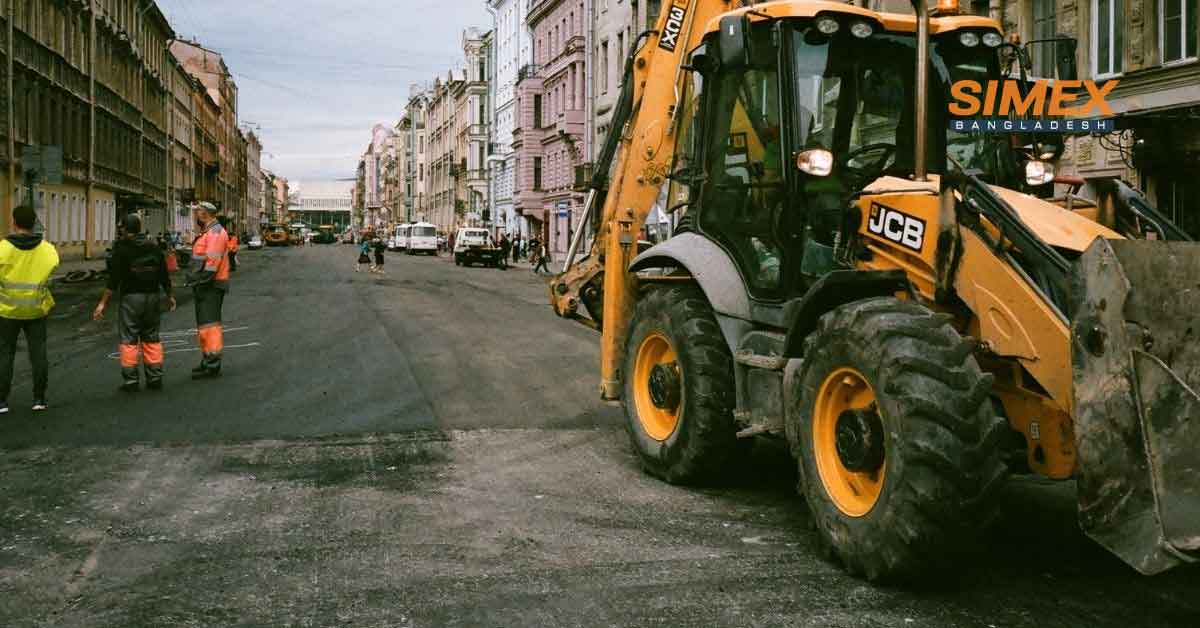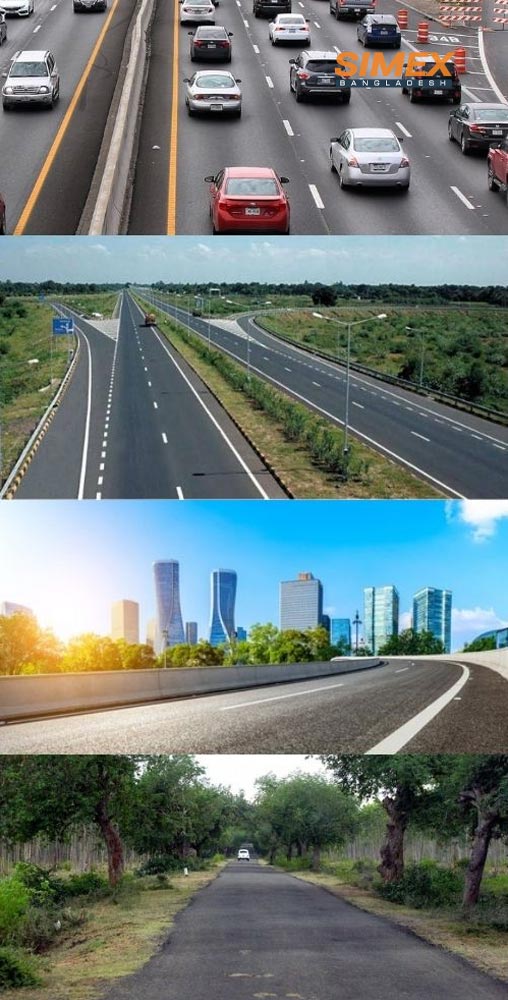
Different Types of Road Construction In Bangladesh
Let's See The Topics
Transport and portability are a key part of the present society. Roads should be durable and safe else they present a threat to their clients and the environment, just as expanding fix costs. And there have multiple classification or types of road construction system in worldwide. Different highway construction company follows the different strategy to finish their projects.
In any case, since they are presented to changing (and outrageous) conditions it is difficult to construct and maintain strong and sturdy roads. Likewise, the nature of segments in street items, particularly bitumen, can shift broadly.
Types of Road Construction
- Materials
- Location & function
- Traffic volume
- Speed and accessibility
- Rigidity
Based on Material
A inclusive types of materials are used in the construction of roads and highways these are soils (naturally occurring or processed), aggregates (fine aggregates or coarse aggregates obtained from rocks), binders like lime, bituminous materials, and cement, and miscellaneous materials used as admixtures for improved performance of roads under heavy loads and traffic. The types of road construction based on materials are following below
1. Earthen Roads
It is the types of roads construction from the usually accessible soil. The establishment, just as the asphalt of the earthen road, is built out of a couple of layers of compacted soil. Subsequent to laying each layer of soil that is compacted with the assistance of rammer or compactor to eliminate the superfluous voids from it. Earth roads are the least expensive of all. Likewise, they are known as transitory roads.
2. Gravel Roads
Gravel roads are the second cheapest among all the types of roads and they are also better than earthen roads. In this type of roads, the mixture of gravel and earth (available soil at the site) is paved on the surface and compacted. Gravel roads are also called as metal roads. These types of roads are easily built and generally laid in villages.
3. Murrum Roads
A particular material is acquired when the crumbling of molten rocks happens due to weathering impact. This specific material is known as Murram. The road constructed with essential material as murram is otherwise called murram roads. Murram road gives a preferred finishing over others.
4. Kankar Roads
The impure form of limestone is generally known as kankar. Kankar roads are by and large constructed where the limestone is accessible in a satisfactory amount and furthermore great quality. The nature of the kankar road isn’t considered as great, yet better than earth and gravel roads.
5. Bituminous Roads
Bituminous roads are widespread roads around the world. They are the most used roads in the world. This road types are low in cost and suitable for driving conditions. The thickness of bituminous roads depends upon the subgrade soil conditions. It generally consists of aggregate spread over sprayed-on asphalt emulsion or cut-back asphalt cement.
6. Concrete Roads
Cement concrete is used to construct the highways in case of concrete roads. These are very popular and costlier than all other types of roads. They are not flexible, so they require less maintenance. Concrete roads are suitable for high traffic areas. The main benefit of concrete road construction is the longevity. Lasting 20-40 years on an average, paving in concrete can boast two to four times the lifespan of asphalt.
Based on Location & Function
1. National Highways
National highways run throughout the length and breadth of the country. These roads connect big cities to the national capital city. A minimum of two lanes, one for each direction is provided for National highways and these two lanes are divided by a strip of stones. The road network consists of many national highways.
2. Zilla Highways
Zilla highways are the classification for all secondary roads in Bangladesh. Zilla highways are paved or have hard packed surface highways. Zilla highways are more narrow in width than Regional Highways, can be hard to trace due the tree canopy adjacent to the highways. During seasonal flooding events Zilla highways can flood and become very muddy or impassable.
3. Urban Highways
Urban highways are limited-access, multi-lane divided roads in populated areas. They are designed to move motorized traffic over long distances at high speeds. Urban highways are located within an urban town planning zone. Urban highways are many types- Express way, Arterial streets, Sub-arterial streets, Collector streets, Local streets.
4. Rural Highways

Rural highways are well-defined as low traffic volume highways located in forested and rangeland settings that serve residential, recreational and resource management uses. They may have been constructed to relatively low standards with a limited budget. These highways lead to the nearest town and also connects to the important areas of the villages like temples, churches etc.
Based on Traffic Volume
1. Light Traffic Roads
The roads which are conveying 400 vehicles per day on average are called light traffic roads.
2. Medium Traffic Roads
On the off chance that a road is conveying 400 to 1000 vehicles each day, it is supposed to be a medium-traffic road.
3. High Traffic Roads
If a road is conveying is in excess of 1000 vehicles each day, it is viewed as a high traffic road.
Based on Speed and Accessibility
The types of road construction based on speed and accessibility are following below. It is most important discussing strategy to road construction process.
1. Freeways
Freeways are likewise called as access-controlled roadways. Freeways are wide streets intended for quick vehicles to travel significant distances with higher speeds. These are by and large planned in four lanes, two lanes toward every direction. Traffic movement on freeways is ceaseless and unhindered on the grounds that there are no railroad or road convergences and no signals.
2. Expressways
Expressways are one of the unrivaled sorts of access-controlled roads where the entry and exit of the expressway are completely constrained by inclines. As the name it “communicates” echoes that these are intended for a free progression of very speed traffic. Expressways are intended to travel rapidly with extraordinary solace and wellbeing by keeping away from sharp bends, occupied intersections, and railroad intersections.
3. Highways
Highways associate towns to urban communities or urban areas to urban communities or state to state or the roads interfaces the state capitals to the national capital are called highways. Highways are the roads gone through the length and broadness of the country. They are by and large laid in two lengths. Highways are additionally arranged into National Highways, State Highways, Urban Highways and Rural Highways. We will examine these sorts in area and capacity class.
4. Arterials
Arterials are the roads laid inside the city or town for the development high volume of traffic. An arterial road joins the focal business to highlight the external local locations. Arterials give admittance to the highways. Walkers are permitted to pass through the roads just at intersections or at the assigned persons on foot intersections. The progression of traffic is constrained by a flagging framework at crossing points.
5. Local Streets
Local roads don’t convey a huge volume of traffic like arterials. Local roads permit you to properties around it. In straightforward the street which you to take to arrive at the closest vegetable market is the nearby road. Walkers can go across the street anytime on nearby roads. Unlimited parking, loading and unloading of vehicles are permitted on local roads. They ordinarily don’t have any divider with stones however separated with 1m dabbed white lines or straight white lines.
Based on Rigidity
1. Flexible Roads
The flexible road has four layers; the external surface layer is finished off with bituminous material which is known as a wearing course and a hidden sub-base, base, and subgrade course. Everything of these layers makes the road adaptable. Periodic maintenance is needed for adaptable streets else they can deteriorate effectively with substantial traffic. All roads except cement concrete roads are flexible roads.
2. Rigid roads
These are the roads with just three layers (Surface course, Base, and Subgrade course) that make the street non-flexible. Concrete cement road falls under this class. Flexible roads comprise an adaptable layer as an asphalt surface, which requires legitimate upkeep; else, they can deteriorate effectively with substantial traffic. A wide range of roads with the exception of substantial roads fall under this classification.
Thus we explain the classification or the types of road construction and it’s detail.
